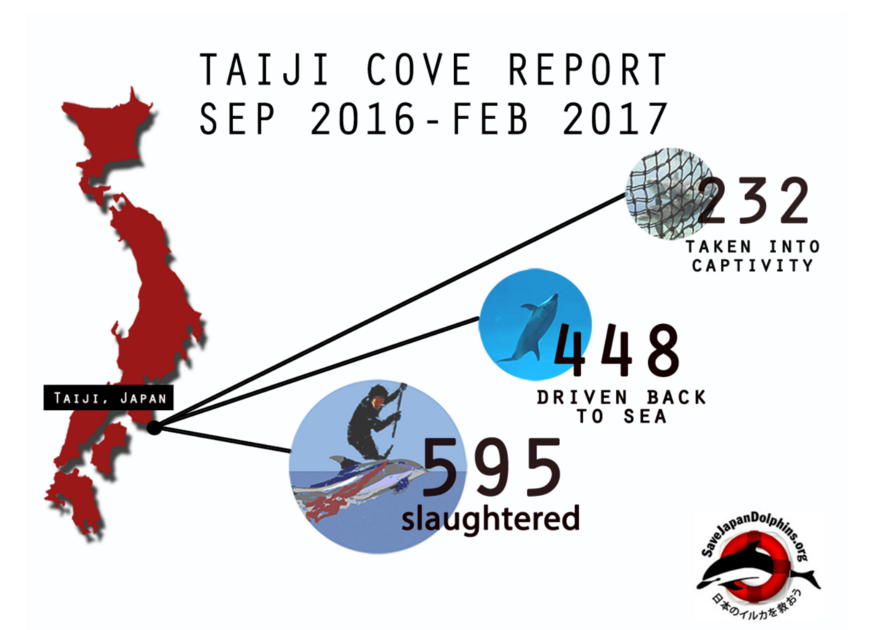

On Feb. 28th, the dolphin hunters at Taiji began removing the banger poles from their vessels and re-rigged their vessels for the bonita fishing season. The 6-months-long dolphin-hunting season came to a close.
(While fishing, dolphin hunters can still harpoon pilot whales that they encounter for the next two months at sea, but the drive hunts have been concluded for the season.)
From Sept. 1st, 2016, through Feb. 27th 2017, according to Ceta-Base, Taiji dolphin hunters slaughtered 595 dolphins for mercury-laden meat and captured 232 dolphins for a life of suffering in captivity. These numbers are based on counts by volunteer monitors in Taiji, so may undercount the actual numbers, not to mention the many dolphins that die from physiological stress and injuries.

Once again, the number of dolphins being slaughtered for sale as meat has been far below quotas and historic levels of exploitation. The quotas are set by the national Japan Fisheries Agency for Taiji and other towns that kill dolphins and/or capture dolphins for the captivity trade, but these quotas are ludicrously high. The overall quota for the 2016-17 Taiji season, for example, was 1,820 dolphins from seven different species. Taiji hunters killed 595 dolphins and captured 232 dolphins for captivity, a total of 827. This represents 45.4% of their quota, matching a trend seen over the past 13 years that Earth Island’s International Marine Mammal Project (IMMP) Campaign to Save Japan Dolphins has been running. We have made some progress in reducing dolphin deaths, but there is clearly much further to go to end the hunts entirely.
Last season (2015-16), 652 dolphins were slaughtered for meat, so this season that just ended is one of the lowest for dolphin kills on record. While the Japanese government insists the dolphin hunts are somehow “traditional”, in fact the drive hunts at Taiji only began in 1969, and only then at the behest of the Taiji Whale Museum which wanted some false killer whales for their live dolphins exhibits.
There are several reasons for the decline in numbers. We have been told by contacts in Taiji that a major reason for the decline in slaughter of dolphins for meat is because fewer Japanese consumers are buying the mercury-contaminated dolphin meat. Our educational efforts have focused on how this dolphin meat is unhealthy and greatly exceeds mercury limits set in the US and the European Union. Dolphin meat was never a particularly sought-after food in Japan anyway, and a lot of the dolphin meat ends up being used in pet food or as fertilizer, while at least some is misleadingly labeled as “whale meat” for consumers, which generally has less mercury contamination than dolphin meat.
Other factors that tend to reduce the dolphin killing include bad weather and the fact that at least some of the dolphin species appear to be declining in numbers, and so there are fewer to catch. False killer whales, for example, have not been captured by Taiji hunters for several years, despite a ludicrous quota of 70 animals set by the Japan Fisheries Agency. Only 20 Pacific white-sided dolphins were captured (quota = 134), and only 170 spotted dolphins were caught (quota = 400).
Of particular concern are the bottlenose dolphins. This species, of course, is the most valuable in terms of the captive dolphin trade. Taiji dolphin hunters drove 469 bottlenose dolphins into the Cove this season, but chose not to slaughter a single one! Many were kept for the captivity trade = 179, while the rest were chased back out to sea. These animals, having been roughly handled and traumatized for days in the Cove, are unlikely to fare well back at sea. Last year, 66 were slaughtered for meat.
As we have often noted, the hidden partner in the Taiji crimes is the international captive dolphin industry, which seeks an endless supply of live dolphins for public aquariums and swim-with-dolphins facilities. Dolphins die frequently in captivity at far younger ages than they do in the wild. A live trained dolphin can sell for as much as $155,000 US or more on the world market. By contrast, a bottlenose dolphin will only bring about $500 US to $600 US for meat.
Yet, the dolphin hunters brought in a whopping 232 dolphins for captivity this hunt season. Compare that to “only” 117 brought in for captivity last season (2015-16) and 80 the season before that (2014-15). The trade in live dolphins internationally is growing, especially in China where aquariums and dolphin shows are big business for the growing middle class. Other countries importing Taiji dolphins include Korea, Russia, and countries in the Middle East. But several of the 232 dolphins brought into captivity were observed to die in the Taiji harbor pens – 7 have been observed being pulled dead from the pens by volunteer observers. Another Taiji dolphin tragically died after being imported to Korea and being in the aquarium for only five days.
Obviously, the many captive dolphins sold in Japan or on the international market easily subsidized the slaughter for meat of hundreds of animals during the season.
And tragically a new hunt season will begin again on September 1, 2017.
IMMP is working to shine an International spotlight on Japan’s shameful dolphin and whale killing before and at the 2020 Tokyo Olympics.
Our deepest thanks to Ceta-Base, the volunteer Cove Guardians of Sea Shepherd Conservation Society , Liz Carter for her amazing videos that have raised international concerns about the captive capture of dolphins at Taiji, and all the other volunteers and organizations working to end the dolphin hunts in Japan once and for all.